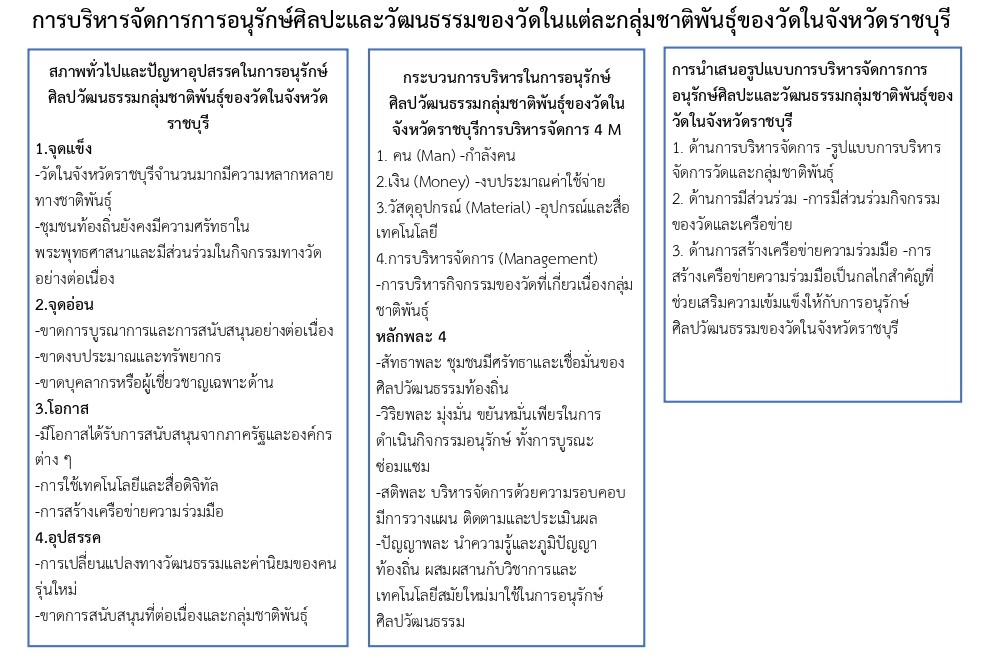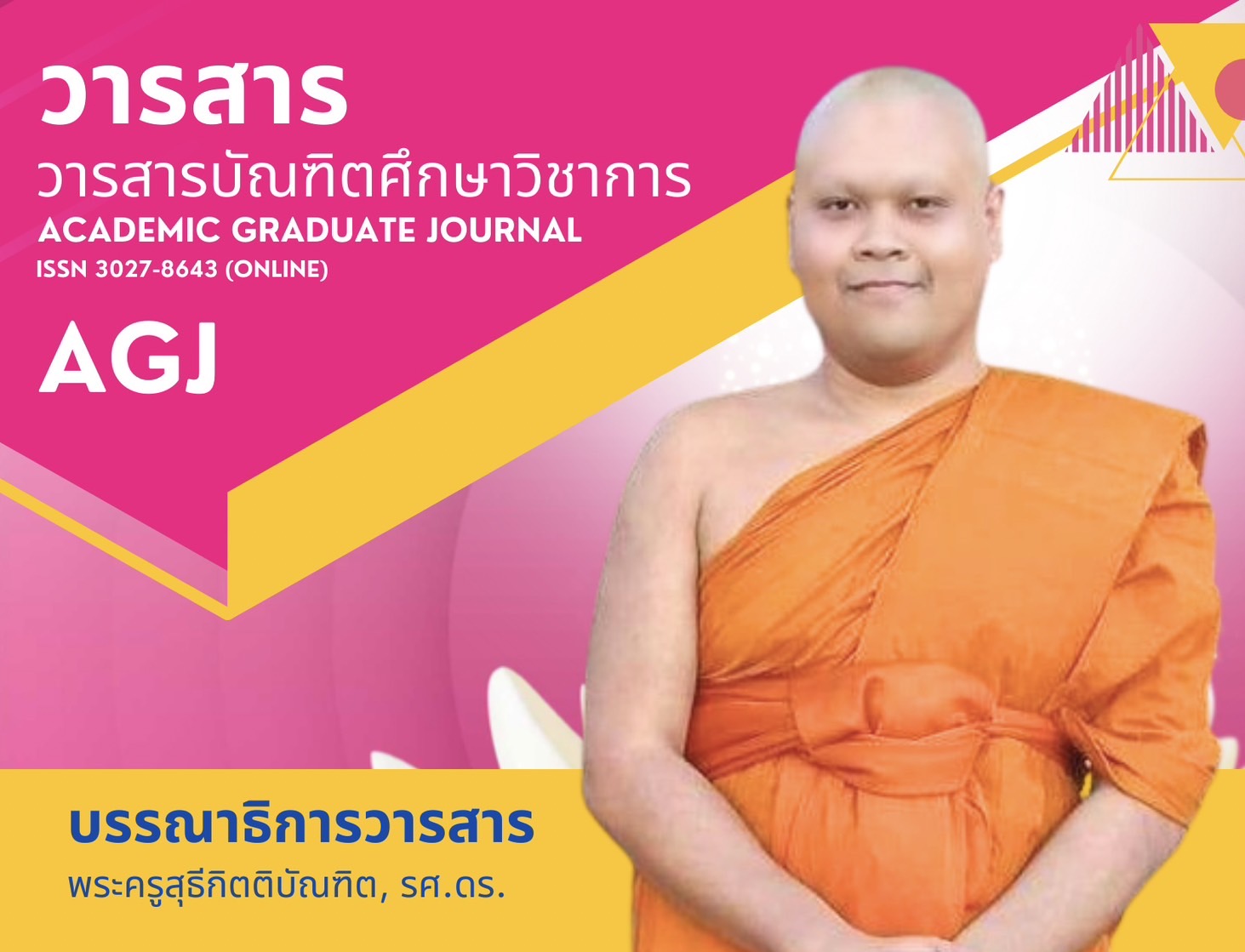DEVELOPMENT OF MANAGEMENT AND CONSERVATION OF ETHNIC ARTS AND CULTURE OF MONASTERIES IN RATCHABURI PROVINCE
Keywords:
Development of Management, Conservation of Arts and Culture, Ethnic GroupAbstract
The objectives of this research article were: 1.To study the general conditions and obstacles in the conservation of ethnic group arts and cultures at monasteries in Ratchaburi Province 2.To study the management processes of conserving ethnic group arts and cultures at monasteries in Ratchaburi Province 3.To propose a development model for managing the conservation of ethnic group arts and cultures at monasteries in Ratchaburi Province This qualitative research was conducted by in-depth interviewing 25 key informants, followed by focused group discussions with 9 participants who were experts. Descriptive content analysis was used to summarize the findings in a descriptive form.
The results of the research were found that 1. General situation of the conservation of Ethnic Art and Culture in monasteries of Ratchaburi Province was found that: Strengths; It lay in the strong community cohesion and the public’s faith in the monasteries, which allowed traditions and cultural heritage to be continuously passed down. Weaknesses; including the lack of expert personnel and limited resources to organize conservation activities. Opportunities; including establishing collaborative networks with government and private agencies, as well as utilizing modern technology and media to promote culture. On the other hand, Obstacles; consisting of the influence of modern culture, which may diminish traditional practices and local wisdom, as well as budgetary and policy limitations. 2. Management Process of Conserving Ethnic Art and Culture in Monasteries of Ratchaburi Province; although the conservation of ethnic art and culture in Ratchaburi monasteries benefited from strong community cohesion and public faith, weaknesses still exist. 3. Management Analysis Using the Bala Four principles and 4M’s approach; the management of ethnic art and culture conservation in Ratchaburi monasteries was analyzed using Bala Four Principles and the 4M’s framework in three areas: management, participation, and network creation. It was found that management was effective in planning and human resource allocation, community participation strengthened the continuity of traditions, and the establishment of collaborative networks provides opportunities for knowledge exchange.
References
เด่น ชะเนติยัง. (2533). การบริหารงานบุคคล. กรุงเทพฯ: ม.ป.ท.
ธีระพล บุญตาระวะ. (2564). การบริหารจัดการทรัพยากรน้ำในจังหวัดปทุมธานี (ดุษฎีนิพนธ์ปรัชญาดุษฎีบัณฑิต สาขาวิชารัฐประศาสนศาสตร์). มหาวิทยาลัยมหาจุฬาลงกรณราชวิทยาลัย.
ปรุงศรี วัลลิโภดม และคณะ. (2543). วัฒนธรรม พัฒนาการทางประวัติศาสตร์ เอกลักษณ์และภูมิปัญญา จังหวัดราชบุรี. กรุงเทพฯ: คณะกรรมการอำนวยการจัดงานเฉลิมพระเกียรติพระบาทสมเด็จพระเจ้าอยู่หัว.
พระระพิน พุทธสาโร. (2559). คู่มือสาระการเรียนรู้สังคมศึกษา ศาสนา และวัฒนธรรม. กรุงเทพฯ: โรงพิมพ์มหาจุฬาลงกรณราชวิทยาลัย.
พระราชญาณวิสิฐ (เสริมชัย ชยมงฺคโล). (2552). การบริหารวัด. กรุงเทพฯ: เอสทีพี เพรส จำกัด.
สถาบันพระปกเกล้า. (2550). วัดระดับการบริหารจัดการที่ดี. นนทบุรี: บริษัท พิมพ์ดี จำกัด.
สุมินตรา สุวรรณกาศ. (2563). คุณค่าภูมิปัญญาของกลุ่มชาติพันธุ์อึมปี้: การวิเคราะห์และการพัฒนา (วิทยานิพนธ์การศึกษาดุษฎีบัณฑิต สาขาวิชาพัฒนศึกษา). พิษณุโลก: มหาวิทยาลัยนเรศวร.
สุรสวัสดิ์ สุขสวัสดิ์. (2542). การอนุรักษ์ศิลปกรรม. เชียงใหม่: คณะวิจิตรศิลป์มหาวิทยาลัยเชียงใหม่.
เสถียร ฉันทะ. (2558). กลุ่มชาติพันธุ์สองฝั่งโขง: กรณีศึกษากลุ่มชาติพันธุ์ขมุในแขวงบ่อแก้ว ประเทศลาวและขมุในจังหวัดเชียงราย ประเทศไทย (รายงานการวิจัย). เชียงราย: มหาวิทยาลัยราชภัฏเชียงราย.







